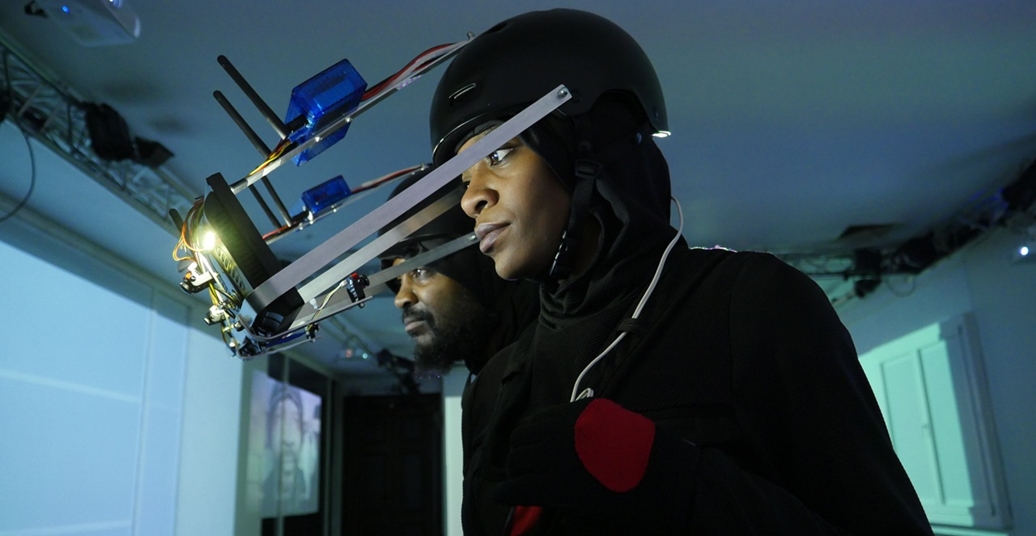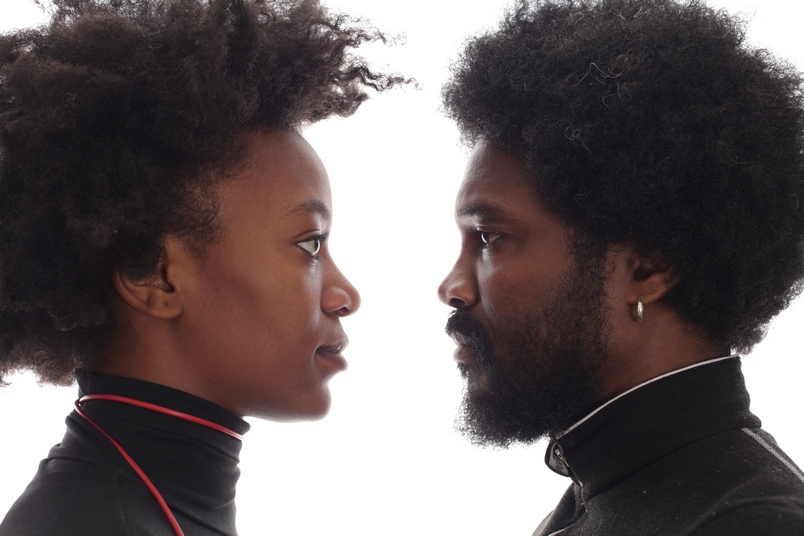“Cyclops”, conceptualized and directed by Zé de Paiva, shows us incomplete abundant fleeting images through his viewfinder. We see images of ourselves and those of de Paiva and co-performer Nasheeka Nedsreal in their avatars as cyborg-ed Cyclops. Images direct and challenge the narrative in this performance that was shown at Ballhaus Naunynstraße.
The gallery in Ballhaus Naunynstraße has groups of audience members sitting in huddles on the floor – some against the walls and some in the centre of the room – facing different directions. Every wall of the room has video projections on them. In this space without a clear proscenium, the dizzying montage of images seem to create some discomfort in me. Seeking to acquire more clues and some more control, I choose to nestle myself in a corner nook from where I can view a maximum number of walls in the room. After all, knowledge is power. And in this room, it is the images that determine knowledge and hold power.
Does my strategy work? We shall see over the next hour of witnessing and being in the gaze of “Cyclops”.
The performers aren’t in the room yet. But before we see them, we see what they see. On a wall in front of me, a video projection shows the outside of Ballhaus Naunynstraße. From the colour of the evening sky in the video, I reckon that this is a live feed. The person whose perspective we are privy to, now proceeds to come into the building. We see their hand press the elevator button, prompting its doors to open. We sense their gait and the pace of their walk from the movement in the video. The projected image on the wall flickers on and off, creating a great sense of anticipation. The video now indicates that the person with the camera has reached the door to the gallery, the one we walked in through moments ago. I relish this slow teasing arrival of the performers, offering us a larger than life presence through an incomplete image.
When the doors are thrown open and the two performers stride in – the anticipation is rewarded by the un-ordinariness of what we see. Zé de Paiva and Nasheeka Nedsreal are dressed in all-black clothes, their heads each fitted into a truss of cameras. The cameras enable a close-up view of both their faces to be captured as footage. Simultaneously another camera captures the visual field in front of them from each of their perspectives. The live feed from all these cameras are projected onto various walls in the space. Hence, de Paiva and Nedsreal hold control of the frame of the cameras depending on where they move and where they look. All the while, their own faces are also constantly monitored. They are the viewers and the viewed. Then again, the audiences too, play the same dual roles. We watch their images and their live moving bodies. In the confined gallery space, videos of the audiences are also captured by their camera truss and projected enlarged on the wall. I catch my own image too on the wall, sometimes a moving glimpse and sometimes a frozen frame. On the wall in front of me, I also see videos of audiences sitting on the other end of the room. I don’t see their physical bodies, but here I eye them through their image. There is also a montage of videos of the two performers from previous rehearsals, performing the same body movements in other spaces, as they do now. The room, every surface, is engulfed in an abundance of images.
De Paiva and Nedsreal actively manipulate how the audience occupies the space. They lead each audience member by the hand and place them elsewhere in the gallery, creating new constellations in the room. To an energizing drum-based beat, they dance weaving their way among the audience that now stands scattered. When Nedsreal does a hip-hop floor shuffle in front of me, I become subsumed in her image-making, my grooving body projected onto a wall in the room that I cannot myself see. De Paiva takes his camera-caged head close to another spectator’s tapping feet and then close to their face, heightening a sense of one’s movements being monitored. It is not merely what is being captured, but also the question of who is in the frame that creates narratives in image-making.
In “Cyclops”, de Paiva also highlights another dimension in the image-making process – the one of who holds the camera. The performers seize the narrative as Black protagonists who drive the spatial arrangement in the room and stage the frame. Not only do they create the image but also define its disruptive dissemination in the room.
In another moment, de Paiva and Nedsreal select random audience members to pose together – staging frames that may be recognized as a classic family photo or images of groups of friends. Implicit in their selection and staging is also an element of race or age defining roles and relationships in the image. Thus, they attest to the role of the camera in colonial history and play with their power as makers of the image. As we watch the performers capture their fabricated frames through a polaroid camera, many questions envelop my mind: How am I being seen? How much of me does the image capture? What I see of you in the image – is it all reality? When I see through a camera viewfinder held by another hand – is it the same as understanding the holder’s perspective?
About a week later, when this article is ready to be published, we realize that tanzschreiber writer David Pallant has already written about the same performance in April 2019. On reading his text “Photo/synthesis”, I am struck by how similar Pallant and my own choices are in our focussing on certain aspects of the performance, and our observations of what transpired. But this accidental overlap is also revelatory of the changed relationships to images in just a short span of over three years. If the time before the pandemic was dictated by the tuning of happiness with public responses to an Instagram post, the COVID19 pandemic led us to retreat indoors and latch on to relationships through the digital medium further – perhaps even as a preferred replacement for the real. Team meetings happened online, and birthday parties and funerals took place on Zoom. Three of my cousins who got married in limited-attendance weddings due to COVID restrictions in India, were witnessed by family and friends through online live-streams. Family elders sent those blessings, deemed irreplaceable and sacred, through digital screens. I took a screenshot on my phone, as I watched my cousin sister and her partner perform their wedding rites. Thus, I inserted my grinning face next to their image and marked my presence. Far beyond airbrushing one’s facial features, it is with no qualms that one can change their background image on video calls – placing oneself in a tropical beach or a distant galaxy. Thus, we declare our dreams from the limits of our four walls. Thus, we learn to actively place the self in a world of images, tossing about the ‘I’ in Cyclops’ all-seeing face. Surely, something about the materiality of images has transformed in these three years. I wonder if these transformations changed the performance “Cyclops” in any way? Or does it merely change its viewing?
Photos: “Cyclops” by Zé de Paiva, Performance: Nasheeka Nedsreal, Zé de Paiva ©Zé de Paiva
After a long time the performance “Cyclops” of Zé de Paiva together with Nasheeka Nedsreal (premiere 4 April 2019) was back on stage of Ballhaus Naunynstraße from 15-18 September 2022.






